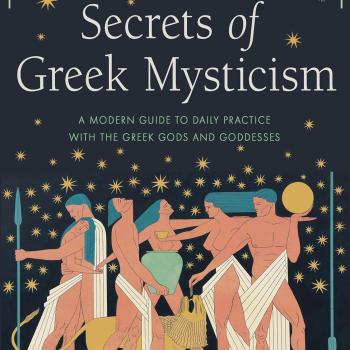Now Featured in the Patheos Book Club
The Saint Who Would Be Santa Claus
The True Life and Trials of Nicholas of Myra
By Adam C. English
From Chapter 1, Finding St. Nicholas
The image of Santa Claus appears on dolls, cookie cutters, ornaments, stamps, stickers, and T-shirts that read, "Beware of fat men bearing gifts." Coffee mugs feature the big man cruising in a hot rod, and neckties depict him relaxing in a Hawaiian shirt and sunglasses. He can be embroidered, printed, or pasted onto magnets, aprons, tote bags, lawn chairs, swimrings, door mats, light switches, plates, napkins, pencil erasers, Pez dispensers, night lights, kick balls, piñatas, and toothbrushes. The more refined consumer might look for old-world Santas in cracked-patina oil paintings, ornately decorated figurines, or delicate Christmas ornaments. The tiny roadside town of Santa Claus, Indiana, has staked its fortunes on selling images of the man in fire-engine red—from novelty gifts to glassware, from museum displays to a Christmas theme park—the town has it all. A special post office located next to the museum receives bundles of letters each year addressed to "Santa Claus," and volunteers work like North Pole elves answering each one. The city of Toronto, Ontario, hosts the world's oldest children's parade in honor of Santa every November. The parade involves more than 1,500 volunteers and draws half a million viewers. And each year, the Macy's Thanksgiving Day Parade culminates with the arrival of Santa Claus driving a sleigh full of toys through the spectator-thronged streets of Manhattan.
Few characters have been represented more often in movies or TV shows than Santa, who has been portrayed by Ed Asner, Leslie Nielsen, Paul Giamatti, and Tim Allen, to name but a few. The bringer of holiday cheer and gifts for boys and girls, Santa is adored by all and hated by none. He evokes good memories and nostalgic longings, childhood dreams and the sweet wish for something magical. Susan, from the 1947 film Miracle on 34th Street declares, "I believe . . . I believe . . . it's silly but I believe."
Most people know that the beloved patron of Christmastime wish-granting has his origins in a vaguely historical personage. But fantasy and historical fact blur rapidly as soon as attempts are made to give the mythical/historical figure a name: Kriss Kringle, Sinterklaas, Santa Claus, Père Noël, Noel Baba, Father Christmas, Pelznichol, Nicolò, Nick, Nicola di Bari, Nicolaus thaumatourgos, and the myrroblite. The barrage of names points to a plurality of personas that makes it difficult to discover the identity of this quicksilver character or whether he did all, some, or none of the feats attributed to him. Although centuries of legends and pop-culture images can obscure the truth about things, historical evidence points to St. Nicholas of Myra as the man who would become Santa Claus. And uncovering the saint behind the myth will provide answers relevant to church history, the traditions of Christmas, and the heritage of Western civilization. The quest of this book is to find the historical man tucked behind the shadow of Santa Claus.
When a tiled mosaic icon of St. Nicholas was dredged up in the early sixteenth century from the Aegean Sea by fishermen near the Greek monastery of Stavronikita located on Mount Athos, metallic-shelled mussels were found clamped to it, covering the saint's forehead and halo. When the mussels were peeled back, some of the mosaic tiles popped off, and legend has it that the icon bled from the forehead during the procedure.1 Reconstructing the life of Nicholas is like trying to clean that icon; it involves more than just locating the right historical documents and spiffing them up a bit. The barnacles of legend, myth, and exaggeration that have cemented themselves to the historical facts must be pried away. And yet, it must be kept in mind that the folkloric barnacles cannot be detached without permanently scarring—or even losing—the person. They are too tightly joined.
The history of Nicholas presents a tantalizing riddle. There is no early documentation of the man—no writings, disciples, or major acts. Then, curiously, story fragments and rumors begin to surface like driftwood in the water. A church is built in his honor at Constantinople, and suddenly he becomes an international symbol of holiday cheer and goodwill, an absolutely essential part of the Christmas tradition. It will take extra care and caution to reconstruct the most plausible account of his life.
[....]
The Image of an Icon
The most pervasive cultural image of Santa Claus today has nothing to do with the digital reconstruction of the bones in the Bari tomb but originated with a landmark ad campaign from Coca-Cola. In an effort to boost winter sales, attract younger consumers, and improve its image after attacks from the Women's Christian Temperance Union, the Coca-Cola Company in the early twentieth century hired artist Haddon Sundblom to paint the big man into its advertisements. From 1931 to 1964, Sundblom produced warm and richly colored Christmas scenes featuring a larger-than-life Santa posing cheerfully in various locations, always with a bottle of Coke. Thirty years of nostalgic, Norman Rockwellesque paintings plastered on billboards and in magazines fixed the modern image of the saint.6 The wide beard of white, the knobby nose, the wind-chapped cheeks, the bright eyes and grandfatherly smile, and of course, the red fur suit with white trim and black belt—this is Sundblom's Santa. Every movie or television or commercial depiction since is based in some degree on Sundblom's vision.




